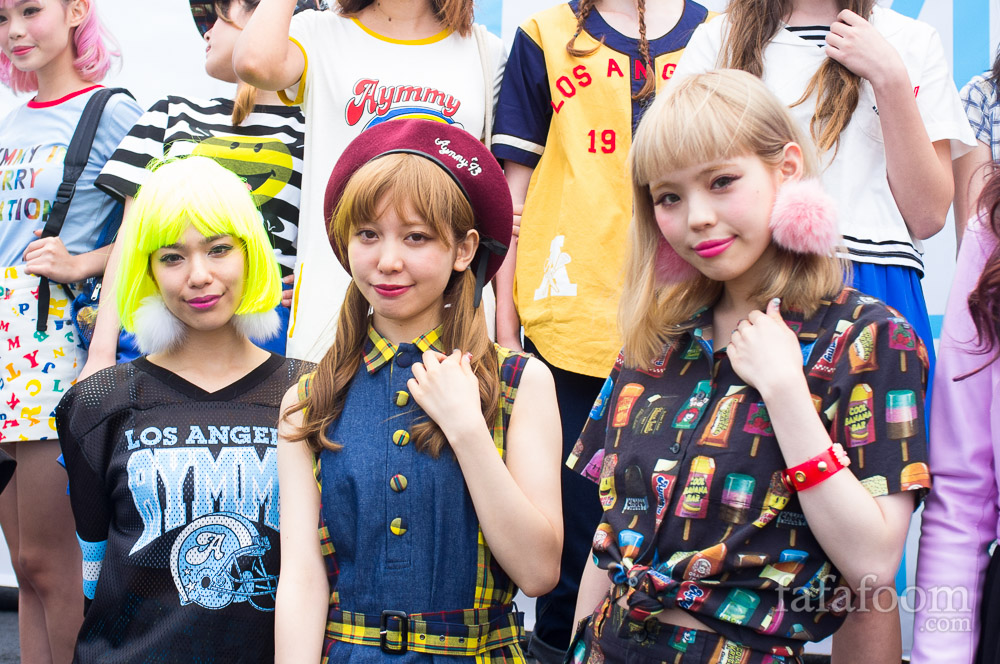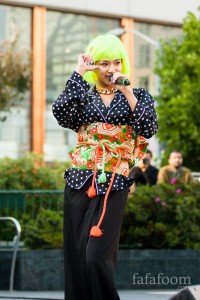During J-Pop Summit 2014, we had a chance to talk to the stars of KAWAii!! fashion segment of the event: Ayumi Seto, Misa Kimura, and Una. The three of them are well-know Harajuku aomoji-kei models who regularly appear in fashion magazines such as Zipper, KERA, FRUiTS, and CHOKiCHOKi GiRLS. Thanks to Asobisystem’s Moshi Moshi Nippon initiative to spread Japan culture awareness globally (I was hooked after seeing the first episode!), they are here to help spread the Harajuku Kawaii fashion culture awareness in the United States.
It’s such a pleasure being in the same room with Ayumi, Misa, and Una. They are very generous in imparting their thoughts, and we get to know about their J-Pop Summit 2014 experience, their personal style and inspiration, as well as Harajuku style tips. As a bonus, we also got to do a super quick (but awesome) photoshoot with each of them! Also, special thanks to Kiyo Hayasaka from YKS Services for being a HUGE help as my translator. Let’s get on with it, shall we?
[shashin type=”photo” id=”14850″ size=”xlarge” columns=”max” order=”user” position=”center”]
Fafafoom: Thank you for being here and spend some time with us for this interview. What do you think about the J-Pop Summit Festival 2014?
Ayumi Seto: I’m really surprised to see A LOT of people here in J-Pop Summit. (laughs) Last time, I went to France and attended Japan Expo, where I get the impression that French people really like Japan culture. Apparently, there are many Americans here that are really into Japanese culture as well! I’m really amazed by it.
Misa Kimura: I’m also most surprised to see American people like Japanese culture. Throughout the fashion show and contest yesterday, I see a lot of people interpreting Japanese culture in their own ways, and that’s really refreshing to see.
Una: It’s my first time participating in a Japan event in America, so I did not know what to expect. I was surprised to see a lot of people know Japanese culture — fashion, music, Japanese idol groups. Even outside of the event, I meet many people who know about all aspects of Japan culture; fashion, music, anime. I’m really happy to see that.
[shashin type=”photo” id=”14856″ size=”xlarge” columns=”max” order=”user” position=”center”]
Fafafoom: Ayumi-san, last year you’re also here and you’ve been traveling to America several times to promote your fashion line Aymmy in the batty girls (available at NEW PEOPLE). What are your plans to build more brand awareness in the United States and is there any plan for expansion in more countries?
Ayumi Seto: I really love America and my brand Aymmy in the batty girls is based on the US culture (i.e.: the 50s pin-up style, diner culture — read this StyleWylde interview with Ayumi about her brand inspiration). Personally I’ve been traveling to the US so many times in the past, and I have this wish to live in L.A. one day.
Fafafoom: Aww, why L.A.? Why not San Francisco?
Ayumi Seto: It’s too cold. (smiles apologetically)
Fafafoom: (sighs) OK, I know, it’s too cold…
[shashin type=”photo” id=”14851″ size=”xlarge” columns=”max” order=”user” position=”center”]
Ayumi Seto: (perks up) But I’d also like to visit New York, and of course I’d like to stay here for as long as possible. As for my brand Aymmy in the batty girls, it’s a Japanese brand and it’s a representation of my interpretation of US culture. However, eventually I wish that my understanding of US culture is being accepted as real American culture by American people. Therefore, my goal is to expand the brand here in the US.
Fafafoom: That’s a great goal. So would you like to have a flagship store?
Ayumi Seto: (looks determined) Yes, I’d love to have a main flagship store in L.A.
Fafafoom: Let’s say you have a flagship store in L.A., where would the next one be?
Ayumi Seto: (hesitates while speaking softly) New York…
Fafafoom: Aw man, no San Francisco? That’s too bad!
Ayumi Seto: (laughs) The third store will be in San Francisco.
Fafafoom: Well, OK then. (laughs)
[shashin type=”photo” id=”14849″ size=”xlarge” columns=”max” order=”user” position=”center”]
Each of you have your distinct styles. Una has a very edgy style, Misa has a sweet style, Ayumi has this childlike coolness (“kids rock”) quality. For day-to-day basis, do you stick within the same theme, or do they experiment with different styles? For example, would you try out Akira’s androgynous gothic look for a change?
Ayumi Seto: (sighs, then laughs) I don’t have a specific dress code or principal per se. The way I dress depends on my mood or purpose. For example, if I go to France, I’ll do a French style, when in America, I’ll do an American style, and next I’m going to London, England so I’ll do an English style.
But whatever I do, I’ll do it according to my own “childlike”, “kids rock” theme. I make sure what I wear is filtered by my own interpretation of the time and place I’m going to.
[shashin type=”photo” id=”14852″ size=”xlarge” columns=”max” order=”user” position=”center”]
Misa Kimura: Depending on the different occasions, I change my styles. I like casual things or girly accents like wearing a ribbon. But I also like wearing strange-looking things, like incorporating a coffee cup in an outfit. Therefore, I like looking girly and a little weird at the same time…I feel that’s cute.
[shashin type=”photo” id=”14855″ size=”xlarge” columns=”max” order=”user” position=”center”]
Una: I really like American culture, especially the west coast music. So my personal style is somewhat based on west coast street style. In addition, I wear a lot of Harajuku style. There’s a great range of things that I love so I cannot pinpoint certain things as my favorites. I like to challenge myself in wearing all kinds of things. Some people may think, ‘Oh, that’s strange,’ but I wear them because I like it.
Fafafoom: This takes me back to your performance yesterday at Union Square. I really love your outfit…it’s so cute! It’s this combination of traditional Japanese mixed with vintage feel. How do you come up with the outfit concept?
Una: (smiles) Ah, thank you! I come up with the outfit coordination idea with my friend. Even though I’m going to the US, the J-Pop Summit is a Japanese event. So I want to express a Japanese sense (the bold colors, obi belt) while also mixing my own distinct character in it.
Fafafoom: So Una-san, in the future will you pursue more of your singing career or modeling career?
Una: 70% of my activity is music-related, the rest is modeling. In the future, I want to continue both singing and modeling.
Fafafoom: If you can only choose one, which career would you choose?
Kiyo: That’s a cruel question! (laughs)
[shashin type=”photo” id=”14854″ size=”xlarge” columns=”max” order=”user” position=”center”]
Una: (looks undeterred) My ideal goal is…I wish to have my name “Una” to become my job. I’d like to do things that represent who I am, and that involves singing and modeling.
[shashin type=”photo” id=”14862″ size=”xlarge” columns=”max” order=”user” position=”center”]
Fafafoom: That’s a great answer! Now, Misa-san, you’re a famous Japanese magazine model. What other things do you like to do beside modeling? I heard you like dancing?
Misa Kimura: Dancing? (looks serious) Yes, I like it very much. (laughs) Well, I like the spirit of challenge and I want to do whatever I can. I really like the idol groups, like Tokyo Girls’ Style, so during this J-Pop Summit event, I interviewed them. I love to learn about them from a fan’s perspective.
[shashin type=”photo” id=”14860″ size=”xlarge” columns=”max” order=”user” position=”center”]
Fafafoom: Now, for an American girl who wants to go to Harajuku and wants to look like Harajuku girls. Do you have tips so they can blend in with the Harajuku style, not seen as a weird foreigner?
Ayumi Seto: There’s no uniform rules of doing Harajuku style, so it’s very difficult to define. It’s what speaks to you personally, so whatever you wear is (your own interpretation of) Harajuku style.
Fafafoom: That’s right, however if I go there just wearing a T-shirt and jeans, that’s not cutting it (as an expression of Harajuku style). So what kind of approach does one need in order to be seen as having a Harajuku sense of style?
Ayumi Seto: I think the hair color is important…I know the Harajuku people definitely sports more vivid hair color.
[shashin type=”photo” id=”14863″ size=”xlarge” columns=”max” order=”user” position=”center”]
Una: Also, the lip color, I notice…
Misa Kimura: Ah, the cheeks, certainly.
Una: Yes, cheeks too. Makeup is definitely important.
Ayumi Seto: Definitely the hair and makeup. American people don’t necessarily do much of them (i.e.: wearing more bold, vivid, bright colors).
[shashin type=”photo” id=”14848,14853,14864″ size=”xlarge” columns=”max” order=”user” position=”center”]
Fafafoom: Let’s do a fantasy scenario. Tomorrow, there’s a Harajuku Kawaii fashion show and the three of you are going to walk down the runway. But you can only wear your own clothes. What will you wear?
Una: I really like to wear clothes I get from second-hand stores, as well as American sports team vintage clothes. So I’d pick a huge-sized sports team T-shirt uniform that has a number on it and wear it as a one-piece dress.
Misa Kimura: I’d wear one-piece dress like a sailor dress, as well as a checkered-patterned piece.
Ayumi Seto: I’d wear an Aymmy in the batty girls clothing, because I design what I want to wear. I also love second-hand and vintage clothes, so I’d want to mix the two of them together.
[shashin type=”photo” id=”14858,14857,14859″ size=”xlarge” columns=”max” order=”user” position=”center”]
We’d love to spend more time chatting with them, but they have more interviews to do that day. So to close our session, Chris started to pull the girls one by one (starting with Una-san) for a little photoshoot by the blackboard in the room. As he was doing that, Kiyo-san and Ayumi-san were commenting on the blackboard on the wall and how it looks like a high-school classroom setting.
After Una-san, Misa-san was next, and Ayumi-san was last. Wow, no wonder these girls are popular; they are complete pros. See the results below!
Una
[shashin type=”photo” id=”14874,14875,14876″ size=”xlarge” columns=”max” order=”user” position=”center”]
Misa Kimura
[shashin type=”photo” id=”14871,14872,14873″ size=”xlarge” columns=”max” order=”user” position=”center”]
Ayumi Seto
Since Ayumi-san was the last one Chris took pictures of, we got some extra snaps! She’s super cute, as if you don’t know it already by now.
[shashin type=”photo” id=”14866,14867,14868,14869,14870″ size=”xlarge” columns=”max” order=”user” position=”center”]
I have to convey my very special thanks to Hiromi-san from J-Pop Summit 2014 staff, who made it possible for us to interview Ayumi Seto, Misa Kimura, and Una. We had a misfortune on the night before and wasn’t sure if we could make it to the interview. As a result, our original interview time slot was canceled. Thanks to her, we were able to make this possible.
Ayumi Seto, Misa Kimura, and Una were so lovely and gracious throughout the interview. It was scheduled last minute and I realized they were tired, so I really appreciate them taking some time to talk to me. (bows deeply)
And once again, thank you to our translator Kiyo-san for her professional service. I’d definitely recommend her Japanese language translation service ANYTIME! Last but not least, an eternal thanks to Christian Hadidjaja for the photos. (winks)
Thank you for reading, until next time,
Musank



Trackbacks/Pingbacks